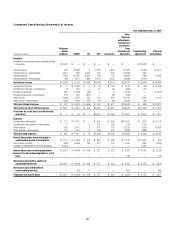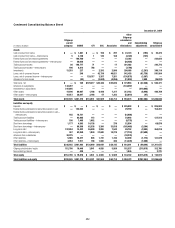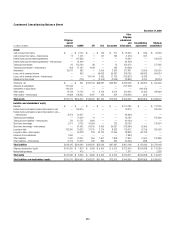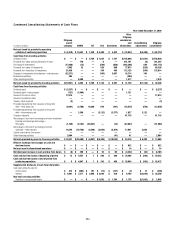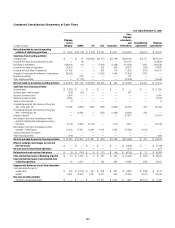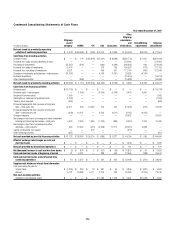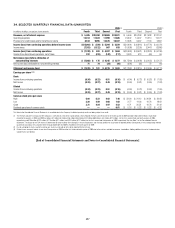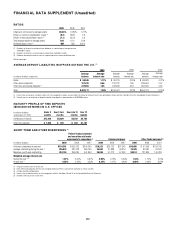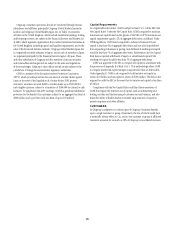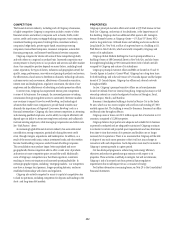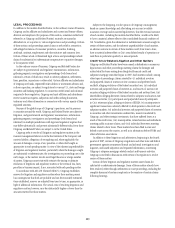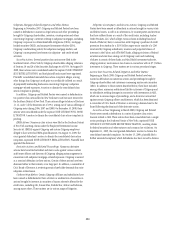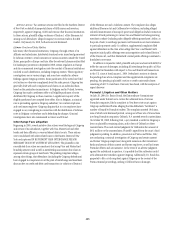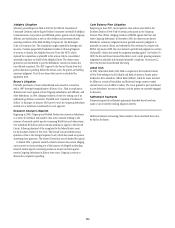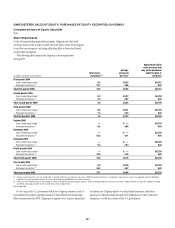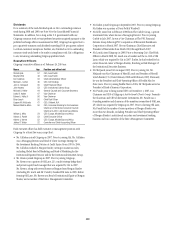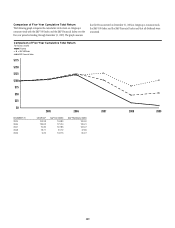Citibank 2009 Annual Report Download - page 270
Download and view the complete annual report
Please find page 270 of the 2009 Citibank annual report below. You can navigate through the pages in the report by either clicking on the pages listed below, or by using the keyword search tool below to find specific information within the annual report.260
Transactions with Non-Bank Subsidiaries
A banking subsidiary’s transactions with a holding company or non-bank
subsidiary generally are limited to 10% of the banking subsidiary’s capital
stock and surplus, with an aggregate limit of 20% of the banking subsidiary’s
capital stock and surplus for all such transactions. Such transactions must be
on arm’s-length terms, and certain credit transactions must be fully secured
by approved forms of collateral.
Liquidation
Citigroup’s right to participate in the distribution of assets of a subsidiary
upon the subsidiary’s liquidation will be subordinate to the claims of the
subsidiary’s creditors. If the subsidiary is an insured depository institution,
Citi’s claim as a stockholder or creditor will be subordinated to the claims of
depositors and other general or subordinated creditors.
In the liquidation of a U.S.-insured depository institution, deposits in
U.S. offices and certain claims for administrative expenses and employee
compensation will have priority over other general unsecured claims,
including deposits in offices outside the U.S., non-deposit claims in all
offices, and claims of a parent such as Citigroup. The FDIC, which succeeds
to the position of insured depositors, would be a priority creditor.
An FDIC-insured financial institution that is affiliated with a failed FDIC-
insured institution may have to indemnify the FDIC for losses resulting from
the insolvency of the failed institution, even if this causes the indemnifying
institution also to become insolvent. Obligations of a subsidiary depository
institution to a parent company are subordinate to the subsidiary’s indemnity
liability and the claims of its depositors.
Other Bank and Bank Holding Company Regulation
Citigroup and its banking subsidiaries are subject to other regulatory
limitations, including requirements for banks to maintain reserves against
deposits; requirements as to risk-based capital and leverage (see “Capital
Resources and Liquidity” above and Note 20 to the Consolidated Financial
Statements); restrictions on the types and amounts of loans that may be
made and the interest that may be charged; and limitations on investments
that can be made and services that can be offered.
The FRB may also expect Citigroup to commit resources to its subsidiary
banks in certain circumstances. However, the FRB may not compel a
bank holding company to remove capital from its regulated securities and
insurance subsidiaries for this purpose.
A U.S. bank is not required to repay a deposit at a branch outside the U.S.
if the branch cannot repay the deposit due to an act of war, civil strife, or
action taken by the government in the host country.
Privacy and Data Security
Under U.S. federal law, Citigroup must disclose its privacy policy to
consumers, permit consumers to “opt out” of having non-public customer
information disclosed to third parties, and allow customers to opt out of
receiving marketing solicitations based on information about the customer
received from another subsidiary. States may adopt more extensive privacy
protections.
Citigroup is similarly required to have an information security program
to safeguard the confidentiality and security of customer information and to
ensure its proper disposal and to notify customers of unauthorized disclosure,
consistent with applicable law or regulation.
Non-U.S. Regulation
A substantial portion of Citigroup’s revenues is derived from its operations
outside the U.S., which are subject to the local laws and regulations of the
host country. Those requirements affect how the local activities are organized
and the manner in which they are conducted. Citi’s foreign activities are
thus subject to both U.S. and foreign legal and regulatory requirements and
supervision, including U.S. laws prohibiting companies from doing business
in certain countries.
Securities Regulation
Certain of Citigroup’s subsidiaries are subject to various securities and
commodities regulations and capital adequacy requirements promulgated
by the regulatory and exchange authorities of the jurisdictions in which they
operate.
Subsidiaries’ registrations include as broker-dealers and as investment
advisers with the SEC and as futures commission merchants and as
commodity pool operators with the Commodity Futures Trading Commission
(CFTC). Citigroup’s primary U.S. broker-dealer subsidiary, Citigroup Global
Markets Inc. (CGMI), is registered as a broker-dealer in all 50 states, the
District of Columbia, Puerto Rico, Taiwan and Guam. CGMI is also a
primary dealer in U.S. Treasury securities and a member of the principal
United States futures exchanges. CGMI is subject to extensive regulation,
including minimum capital requirements, which are promulgated and
enforced by their Designated Examining Authority, the Financial Industry
Regulatory Authority (FINRA), the Chicago Mercantile Exchange and various
other self-regulatory organizations of which CGMI is a member. The SEC and
the CFTC also require certain registered broker-dealers (including CGMI)
to maintain records concerning certain financial and securities activities of
affiliated companies that may be material to the broker-dealer, and to file
certain financial and other information regarding such affiliated companies.



